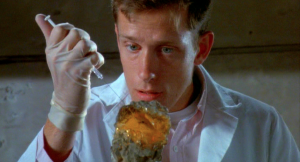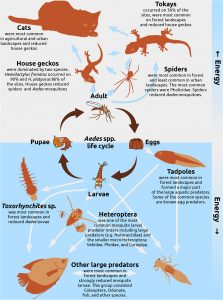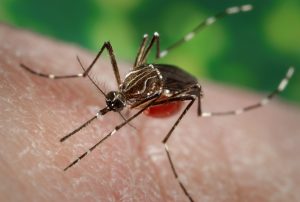Guest Post By Lyndsey Gray, 2020-2021 Sustainability Leadership Fellow and Ph.D. Candidate in the Department of Microbiology, Immunology, and Pathology
When I was a kid, no movie fascinated me or terrified me more than Jurassic Park. I can still viscerally remember the first time I watched the film. Sitting in front of the TV in my family’s dark basement, I watched as John Hammond escorted scientists around his dinosaur-filled Disney Land, promising entertainment, scientific discovery, and riches beyond belief. Of course, it was obvious that the project would fail and the dinosaurs would escape. What I and many of the movie’s fans didn’t expect, though, was how completely incapable the expert scientists would be at containing them, and how horrifying the consequences would be.
As an adult, I still think about how that movie influenced my decision to become a scientist. In fact, my research focusses on the very animal that preserved and provided the dinosaur DNA Hammond needed to start his ill-fated amusement park: mosquitoes. So, when my Florida-based family heard of their state’s upcoming plan to release 750 million genetically modified mosquitoes, they reached out to me. When a wild and genetically modified mosquito mate, any daughters that they have will die before they reach adulthood. As such, these genetically modified mosquitoes serve as new way to control and reduce mosquito populations. While there certainly is a lot to unpack here, what’s also striking is a statement released by the International Center for Technology Assessment and Center for Food Safety: “With all the urgent crises facing our nation and the State of Florida […] the administration has used tax dollars and government resources for a Jurassic Park experiment.”

Even as someone with nearly a decade of experience researching mosquitoes and infectious diseases, my immediate reaction was to remember the panic that I felt when I was five years old, watching dinosaurs wreak havoc and thwart scientists on a fictional island. When thinking about the potential release of millions of genetically modified organisms (GMOs) into the wild, I could understand why Dr. Malcom disgustedly proclaimed, “Your scientists were so preoccupied with whether they could, they didn’t stop to think if they should.” So, let’s follow his advice and stop and think. What really are GMOs, and why do we fear them?
Genetically Modified Mosquitoes: Friend or foe?
There are a lot of misgivings around GMOs in part because of what they are. Most would loosely define a GMO as an organism whose DNA has been intentionally altered by humans in a lab using modern genetic engineering techniques. Working off of this popular definition, it’s easy to see how GMOs are considered synthetic, ‘unnatural,’ and different, qualities that many have difficulty accepting. For this reason, GMOs often get a bad rap right out of the gate. But if people inherently distrust GMOs for what they are, then they are even more wary of the risks they are perceived to pose.

I’m going to come right out and say it: humans are pretty terrible at accurately assessing risk. After all, the average person is far less afraid of texting while driving than they are of shark attacks, even though the former causes exponentially more deaths each year than the latter. Why? Because conducting emotion-based risk assessment is faster, easier, and more intuitive than using logic. We also know that when people make decisions, they weigh the prospect of losses and gains differently. In general, the risk of losing something or experiencing some sort of adverse consequence, however small or unlikely, often influences decision making more than the prospect of gaining something. So, you can understand why many have reservations about moving genetically modified mosquitoes out of the lab and into our green spaces. It’s not just that they’re GMOs (though that does play into it); the risks they pose, no matter how improbable, are considered more important than their benefits.
I certainly do not want to ignore the risks of releasing genetically modified mosquitos. How will these mosquitoes impact preexisting food chains? Do they place undue strain on ecosystems? These are questions that we do not, nor likely will we, have complete answers to. Scientists cannot fully predict or examine every single type of situation genetically modified mosquitoes will encounter in the wild, how they’ll adapt and react, or how nature will react (or not) to them. Unfortunately, none of us have this sort of foresight (If you do, please contact me. I’d love to know when I’ll graduate).
When it comes to risk assessment, though, there’s another question we have to consider before we come to any conclusion concerning genetically modified mosquitoes: What are the health and environmental risks of leaving wild mosquitoes unchecked?
One Mosquito, Many Dangers
Even the most die-hard insect enthusiasts have difficulty loving mosquitoes. Their itchy bites, high-pitched buzzing, and widespread prevalence can easily ruin a summer backyard gathering or outdoor hike. But they’re more than just a nuisance. Mosquitoes are also the deadliest animal on the planet. Collectively, mosquitoes are responsible for several million deaths each year, and hundreds of millions of disease cases annually. Although there are over 3,000 different species of mosquitoes, some are more villainous than others. Chief among them is the Aedes aegypti mosquito, the very mosquito species that has been genetically modified and is due for release in Florida.

From a public health standpoint, Aedes aegypti is often seen as public enemy number one. This species is incredibly efficient of transmitting multiple viruses, including Zika, dengue, yellow fever, and chikungunya, to humans. Although it is also true that all of these viruses may result in a much milder, fever-like illness, the severest cases result in a serious loss of human life and wellbeing all over the world.
Even though some geographic areas and people groups experience higher risk of suffering from these diseases than others, very few are absolutely safe from this mosquito. Currently, more than half of the world’s population live in areas where Aedes aegypti is present. That includes those living in Florida. Florida not only has the most reported cases of dengue in the USA; it also experienced the country’s first Zika outbreak. This makes the state ‘ground zero’ in the American fight against Aedes aegypti. As such, we need an effective weapon to keep mosquitoes at bay. The good news is: we have one. The bad news is: it’s problematic.

To control mosquito populations, we rely extensively on chemical-based insecticides. Though these chemicals are designed to break down in the environment, they still aren’t a truly environmentally friendly option. When insecticides are applied to kill mosquitoes, other beneficial insects, like honeybees, get caught in the line of fire and die. Consequently, there is no way to use insecticides without also placing vulnerable species and food chains at risk. But, that’s not their only drawback. When mosquitoes are continuously exposed to low doses of insecticides, they become resistant towards them. That resistance can also be passed down to their offspring, making generations of insecticide-resistant mosquitoes. To kill these fortified mosquitoes, you either need higher concentrations of insecticide, deadly insecticide ‘cocktails’ that mix different types of chemicals together, or completely new chemical products that mosquitoes have never encountered. Regardless of which option is picked, there will, yet again, be a negative environmental impact.
Welcome to Jurassic Park
Either way you look at it, Aedes aegypti mosquitoes pose a very real, and a very serious risk both from a human health and an environmental health perspective. This is why we need to explore and find other, non-chemical insecticide-based means of controlling mosquito populations. And, that need is only increasing in the face of climate change. As temperatures rise and weather patterns change, Aedes aegypti will likely be able to further expand its global distributionand pose even more of a public health problem. When and as it does, we are going to need a variety of weapons to keep the mosquitoes at bay, some of which should include alternatives to chemical insecticides.
I can’t deny the risks that genetically modified mosquitoes pose and, I’d argue, you shouldn’t either. We must continue exploring and evaluating those risks, and we need to make sure that communities, not just scientists, are involved in those conversations as well. After all, once we release genetically modified mosquitoes into the wild, it will be hard to put the toothpaste back in the tube, as they say. But, to go so far as to say that the Florida mosquito control project is akin to Jurassic Park is more than a bit unfair.
If we’re going to use the Jurassic Park analogy here, then let’s use it correctly. Let’s use it to describe the situation that poses the greatest risk. The one that truly inflicts the most harm to the world we live in. The one that’s hardest for scientists to contain. If we do, then we have to acknowledge a rather unsettling reality: we’re already living in Jurassic Park. Aedes aegypti are running around lose, causing serious harm to humanity and the environment in the process. It’s time to control the mosquitoes, and GMOs may help us do just that.






